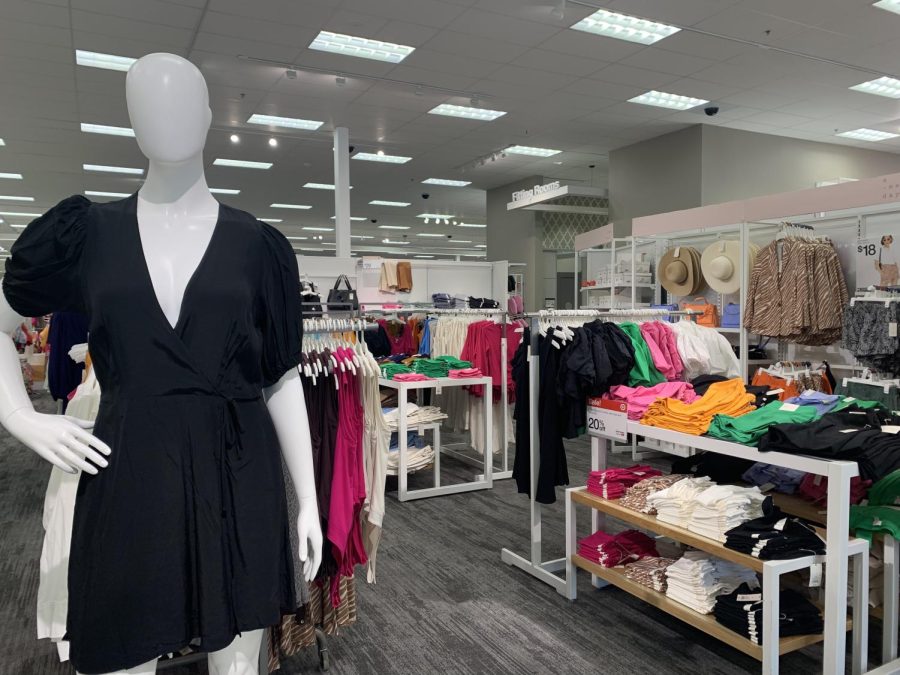Clothing Can Be ____: A War on the Fast Fashion Industry
Target, one of the biggest box stores, competes as a readily available source of fast fashion.
March 1, 2023
Americans’ lives are busier than ever, ask anyone around you how much free time they have to go to the mall, and you might just be greeted by a laugh. Fast fashion is all around us: Instagram, Snapchat, Tiktok, and so many more platforms are paid millions of dollars by fast fashion brands to advertise their clothes around the internet. Our desire for fast and convenient shopping is driven by a variety of factors, many of which are: longer working hours, development of online shopping, and the accessibility of technology. As convenient and fun as a Shein shopping spree is, what effects do these mega corporations have on our planet and the people working in these factories?
In a statement by Alex Assoune; the founder, owner, and Chief Executive Officer of Panaprium, the global digitally-native sustainable fashion brand, he states, .
With over half of the United States purchasing from fast fashion distributors such as Zara, Forever 21, H&M, and Shein, the global clothing pollution is exponential. In order to have an earth to live on in the future, we must slow down these practices. In an article by Audrey Lin, a head writer at Earth Day, a growing movement since the 1970s, she shines a light on the staggering statistics of fast fashion, “The manufacturing of clothing is responsible for 2-8% of annual greenhouse gas emissions. This is more than all international flights and maritime shipping combined…the industry overall is responsible for 20% of all industrial wastewater… every year landfills and incinerators fill with 40 million tons of discarded clothing” (Lin). And numbers are only spiraling faster and faster, the global apparel industry is expanding at a 6.16% compound annual growth rate, and does not plan on stopping anytime soon (Assoune).
Along with the environmental effects of fast fashion, citizens of low-income countries are taken advantage of, with labor being extremely cheap. Audrey Lin continues, “…In April of 2013, a building in Bangladesh housing five garment factories collapsed, killing 1,132 people and injuring more than 2,500. Garment workers continue to face life-threatening working conditions just to be paid as low as $3.43 per day” (Lin). Such drastic working conditions are hardly worth the result of their factory’s products.
Many people joke about the “Shein expiration date,” noting how short their items from the Chinese company last. Shein’s interface specifically rewards their members with coupons if they leave 5 star reviews on their products, effectively drowning out all quality complaints. Fashion blogger Ines Fressynet gives a statement on how she was tricked into this false illusion of cheap, high quality stylish products, “There are no words to describe how ill-fitting and poor quality the items were when they arrived..My first impulse was to throw all of them away, which says a lot for someone like me who is conscious of living a low waste lifestyle. But in my view, that’s where Shein’s clothing belongs: in the bin” (Euronews). Swiss Advocacy Group and NGO Public Eye dove into just how dangerous Shein’s product cycle is, .
This extreme labor is primarily driven by Shein’s payment policy, only paying their workers on a ‘per-piece pay rate’, when payment is based on the number of garments a worker completes, also contributing to Sheins appalling quality. Not only are the effects of these hours highly dangerous, but they also violate Chinese working standards.
But with such a strong cycle of clothing corruption, what can be done?
Keep these things in mind while shopping: Do I really need this item? Am I buying this because I like it, or because it’s a trend? Will this fit with my clothes at home? How many times will I wear this? Can I find this somewhere else that has better environmental policies? Speaking of businesses with better work policies..
Stores with better environmental policies than Shein and the others. (stylish
clothing.. without the environmental baggage.. no way!)
– https://www.wildfang.com/
– https://www.nobodyschild.com/us?glCountry=US&glCurrency=USD
– https://www.wills-vegan-store.co.uk/?ref=TeZTUVTN
– https://veganoutfitters.com/
– https://www.happyearthapparel.com/?sscid=11k7_dtvg8&
– https://yesfriends.co/
– https://www.komodo.co.uk/
– https://plantfacedclothing.com/
– https://www.dapperboi.com/collections/instock
– https://www.stuzoclothing.com/collections/all
– https://www.automicgold.com/collections/rings
– https://www.humankindclothing.com/
– https://www.nosesso.la/
Unfortunately with fast fashion remaining so popular, small clothing brands such as the ones listed above are shut out of the consumer market. This shutout requires small business owners to raise their prices, keeping them locked out even further. But with more attention to their brands, prices will lower and more people can shop green. If price is a large contributor to your clothing choices, a great green alternative is thrifting. Best part is, thrift stores go both ways! If you own items you no longer need, donating to clothing stores or local thrift shops is a great way to continue the cycle of clothing recycling on a local level.
Happy Shopping!
Works cited
Assoune, Alex. “Top 10 Reasons Why Fast Fashion Is so Popular.” Panaprium, 28 Oct.
2021, https://www.panaprium.com/blogs/i/fast-fashion-popular.
Fressynet, Ines. “Shein: The $100 Bn Fast Fashion Brand Where Staff Work 75-Hour
Weeks.” Euronews, 1 Dec. 2022, https://www.euronews.com/green/2022/04/05/welcome-to-the-dark-side-shein-is-the-biggest-rip- off-since-fast-fashion-was-born.
Lin, Audrey. “Driven to Shop: The Psychology of Fast Fashion.” Earth Day, 17 Aug. 2022, https://www.earthday.org/driven-to-shop-the-psychology-of-fast-fashion/.
Tidswell, Emma. “19 Sustainable Clothing Brands for Cool & Conscious Teens.” Goodmakertales.com, 25 Jan. 2023, https://goodmakertales.com/sustainable-clothing-brands-for-teens/.





















